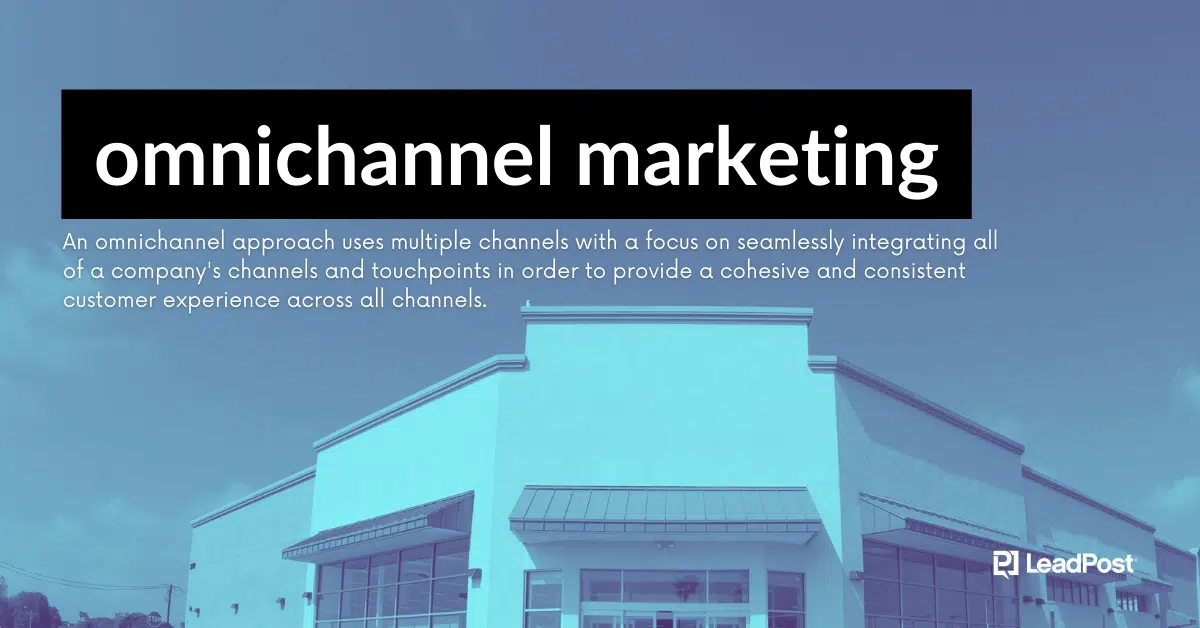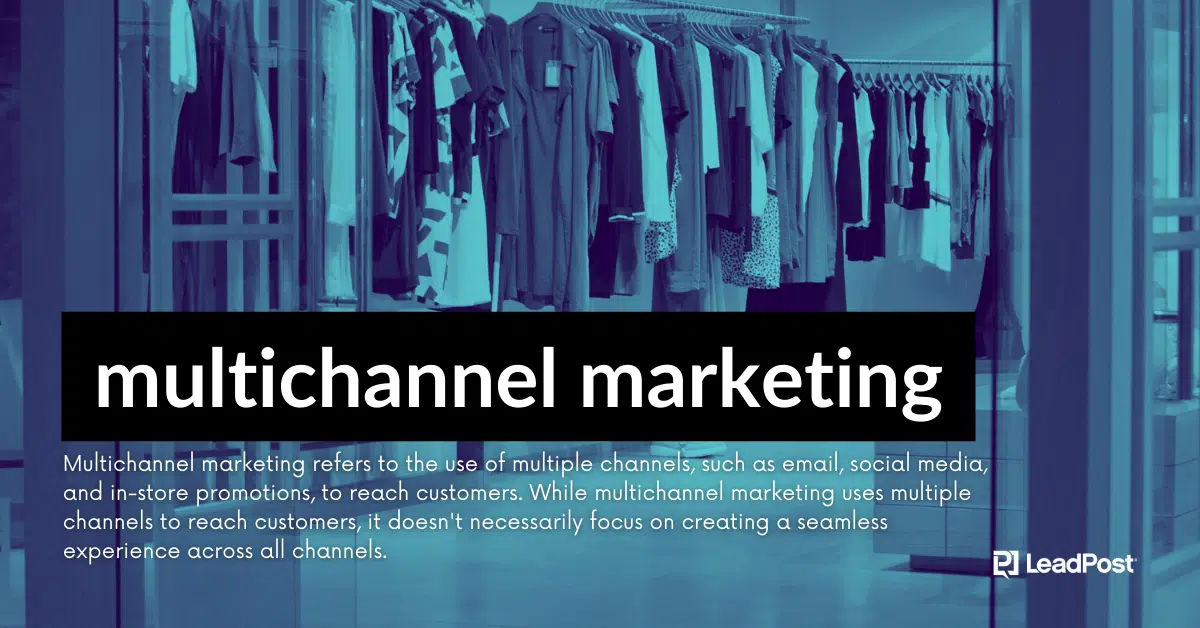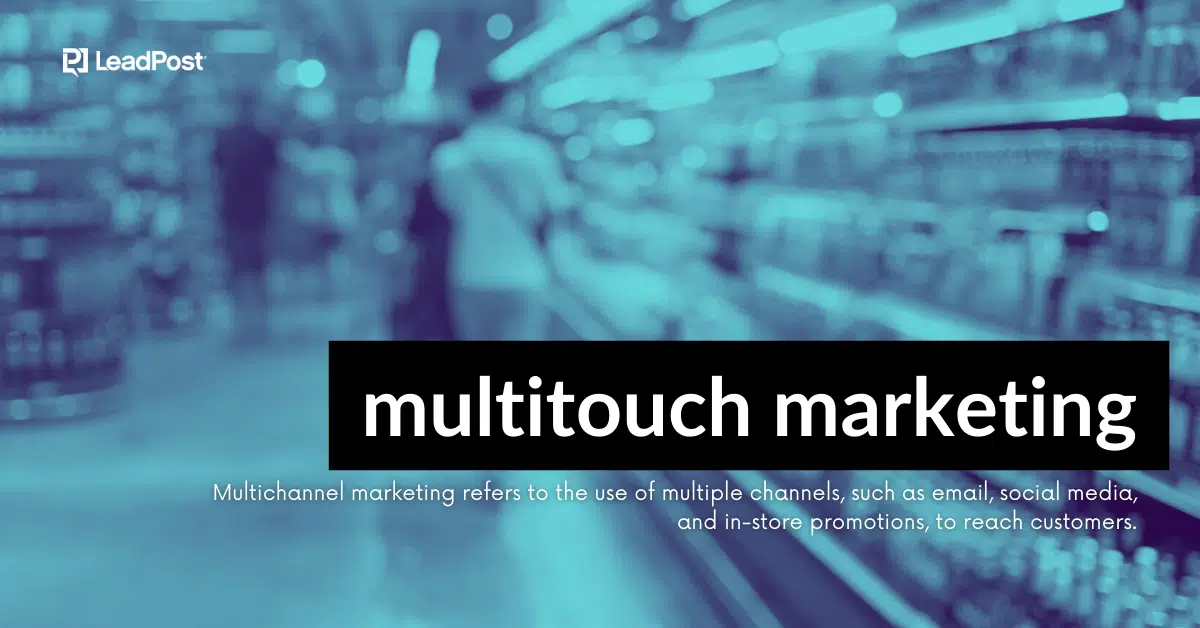In today’s digital landscape, it’s more important than ever to have a comprehensive and cohesive marketing strategy that reaches customers across multiple channels. We recommend multitouch, omnichannel marketing campaigns. The goal of this approach is to build trust and establish a relationship with the customer, increasing the chances of conversion.

In this article, we’ll explore how to use multitouch, omnichannel marketing campaigns to win more customers.
What is Omnichannel Marketing?
An omnichannel approach uses multiple channels with a focus on seamlessly integrating all of a company’s channels and touchpoints in order to provide a cohesive and consistent customer experience across all channels.

What’s the Difference Between Omnichannel Marketing and Multichannel Marketing?
Omnichannel marketing is an extension of multichannel marketing, which refers to the use of multiple channels, such as email, social media, and in-store promotions, to reach customers. Omnichannel marketing is similar to multichannel marketing, but there is a key difference. Omnichannel marketing focuses on a cohesive, consistent customer journey.
Multichannel marketing uses multiple channels to reach customers, but it doesn’t necessarily focus on creating a seamless experience across all channels. The channels used in multichannel marketing may operate independently of each other, with little integration or coordination.
The main focus of the multichannel approach is on using different channels to reach different segments of customers, rather than creating a cohesive and integrated experience. Omnichannel marketing is designed to make sure that customers are getting the same level of service and information no matter what channel they are using.
This approach often involves using customer data and preferences to deliver personalized, relevant messages and offers to customers, regardless of the channel they are using. In other words, Omnichannel marketing is an extension of multichannel marketing, which is more integrated and coordinated.
How Does Omnichannel Marketing Work?
Omnichannel marketing relies on a combination of strategies and technologies.
- Centralized Customer Data. Omnichannel marketing relies on a centralized customer database that contains data from all channels and touchpoints so that the company can have a complete view of the customer’s interactions and preferences.
- Consistent Branding and Messaging. Omnichannel marketing ensures that branding and messaging are consistent across all channels, so that customers have a clear and recognizable experience, regardless of the channel they are using.
- Personalization. Omnichannel marketing uses customer data and preferences to deliver personalized, relevant messages and offers to customers, regardless of the channel they are using.
- Integrated Systems and Processes. Omnichannel marketing requires the integration of various systems and processes, such as order management, inventory management, and customer service, across all channels, to ensure a seamless experience for customers.
- Employee Training. Omnichannel marketing requires employees to be trained on the latest technologies and processes, as well as customer service skills, to be able to provide consistent service across all channels.
By using these strategies and technologies, omnichannel marketing delivers a cohesive and consistent customer experience.
The Benefits of Omnichannel Marketing
There are seven primary benefits of omnichannel marketing, and they all combine to improve revenue for your company.
- Improved Customer Experience. A cohesive and consistent customer experience across all channels leads to a better overall customer experience and increased customer satisfaction.
- Increased Customer Loyalty. A more personalized and relevant experience for customers leads to increased customer loyalty and repeat business.
- Increased Conversions. The seamless and integrated customer journey makes it easier for customers to convert, which leads to increased conversions and sales.
- Increased Brand Awareness. Reaching customers across multiple channels leads to increased brand awareness and visibility.
- Better Customer Insights. Collecting and analyzing customer data from multiple channels leads to better customer insights and a deeper understanding of your customer needs and preferences.
- Increased Efficiency. Since your company can automate and optimize customer interactions and engagement across all channels, you’ll see increased efficiency and cost savings.
- Increased Customer Lifetime Value (CLTV). Omnichannel marketing builds trust and relationships with customers, which leads to increased CLTV and more repeat business.
What is Multitouch Marketing?
Multitouch marketing is a strategy that involves multiple interactions or “touches” with a potential customer before they make a purchase. The idea is that the more interactions a customer has with a company or brand, the more likely they are to become a customer.
This approach usually involves a series of marketing campaigns that are designed to educate, nurture, and convert leads into customers over time. This can include email campaigns, retargeting ads, social media posts, and other marketing channels you have available. Each interaction is designed to move the customer further along the sales funnel until they are ready to make a purchase.

Multitouch marketing is often used in B2B and enterprise sales, where the sales cycle is longer and more complex, and it is also commonly used in account-based marketing. But it can be effective in any context.
By using multiple interactions, multitouch marketing helps to build trust and establish a relationship with the customer, increasing the chances of conversion.
How to Combine Omnichannel Marketing with a Multitouch Approach
Marketers can combine multitouch marketing and omnichannel marketing by creating a cohesive and integrated customer journey that involves multiple interactions or “touches” across multiple channels.
- Segmentation. Marketers can segment their customer base based on their behavior and preferences, and create targeted campaigns that align with each segment’s unique needs and interests.
- Personalization. Marketers can use customer data and preferences to create personalized, relevant messages and offers across multiple channels, to build trust and establish a relationship with the customer.
- Integrated Systems. Marketers can use integrated systems and processes to track customer interactions and engagement across all channels and use this data to create a comprehensive view of the customer journey.
- Consistent Messaging. Marketers can use consistent branding, messaging, and imagery across all channels to create a cohesive and recognizable experience for the customer.
- Continuous Improvement. Marketers can continuously review and optimize their multitouch, omnichannel campaigns based on customer feedback and engagement data, to ensure that they are effectively moving leads through the sales funnel.
By combining multitouch marketing and omnichannel marketing, marketers can create a cohesive and integrated customer journey that involves multiple interactions across multiple channels, helping to build trust and establish a relationship with the customer, increasing the chances of conversion.
Here’s how that looks in practice.
- Email Campaigns. Email campaigns are an important part of omnichannel marketing. Use customer data and preferences to create personalized, targeted campaigns that align with each segment’s unique needs and interests. These emails can be sent over a period of time, each one building on the previous one, and with a call to action that directs the customer to a landing page.
- Retargeting Ads. Retargeting ads enable you to reach customers who have previously interacted with your brand. Use consistent branding, messaging, and imagery across all channels to create a cohesive and recognizable experience for the customer.
- Social Media. Use social media as part of your multitouch, omnichannel marketing strategy and use customer data and preferences to create personalized, targeted campaigns that align with each segment’s unique needs and interests. Also, use social media to engage with customers and build trust by responding to comments and messages in a timely and personalized way.
- CRM. Use your CRM to track customer interactions and engagement across all channels, including email, social media, and web analytics, and use this data to create a comprehensive view of the customer journey. This can help them to identify patterns and trends, and optimize their multitouch, omnichannel campaigns accordingly.
- In-Person. Use in-person interactions, such as events, trade shows, and in-store promotions, as part of a multitouch marketing strategy. These interactions can be integrated with digital channels and data, to create a cohesive and integrated customer journey.
By using these specific examples, marketers can create a cohesive and integrated customer journey that involves multiple interactions across multiple channels, which leads to a higher conversion rate.
A Real-World Example of Omnichannel Marketing in Action
Starbucks is a company that is well known for its effective omnichannel marketing strategy. Some examples of how Starbucks uses omnichannel marketing include:
- Mobile App. The Starbucks mobile app allows customers to order and pay for their drinks in advance, and then pick them up in-store. The app also allows customers to manage their loyalty program, earn rewards, and track their purchases.
- In-Store. Starbucks uses in-store promotions, such as limited-time offers and seasonal drinks, to drive sales and keep customers engaged. They also use in-store displays and point-of-sale materials to promote new products and special deals.
- Social Media. Starbucks uses social media, such as Instagram and Facebook, to connect with customers and promote new products and special deals. They also use social media to engage with customers, by responding to comments and messages in a timely and personalized way.
- Email Marketing. Starbucks uses email marketing to promote new products, and special deals, and to keep customers engaged with their loyalty program. They also use email marketing to promote special events and seasonal promotions.
- Personalization. Starbucks uses customer data, such as purchase history and preferences, to create personalized and relevant offers for customers, such as personalized drink recommendations.
- Gift Cards and Loyalty. Starbucks uses a loyalty program and gift cards to keep customers engaged, and to encourage repeat business. The company uses personalization to determine what it incentivizes for each customer.
How to Run an Omnichannel Campaign on Autopilot
LeadPost is a website visitor identification and retargeting automation platform that you can use to combine multitouch marketing and omnichannel marketing by automating. Here’s how.
- Lead Generation. Identify your anonymous website visitors with LeadPost so that you can serve them targeted lead generation campaigns across multiple channels, including email, display ads, paid social, and direct mail.
- Data Collection. LeadPost will collect and store lead data in a centralized CRM, making it easy for you to segment and personalize campaigns based on personal attributes like age, sex, income range, and more.
- Lead Nurturing. LeadPost can be used to create automated lead nurturing campaigns that involve multiple touches over time. It can be used to send personalized, targeted emails, direct mail, and social media ads, and use lead data to personalize the content of each message through dynamic injection.
- Lead Scoring. With the data you collect through LeadPost, you can assign a score to each lead based on their engagement, interactions, and demographic details, which can be used to identify which leads are most likely to convert. You can focus your nurturing efforts on those leads.
- Marketing Optimization. LeadPost can be used to track leads across multiple channels and provide a comprehensive view of the lead’s journey, by using web tracking and analytics, so you can see which campaigns are most effective.
- Lead Routing. Use the information LeadPost collects to route leads to the appropriate sales team member or account manager, based on the lead’s score, demographics, or other criteria, ensuring that leads are followed up on in a timely and personalized way.
Let’s say you’re a fashion retailer promoting a new clothing line and you want to run an omnichannel marketing campaign.
- Email. Send out an email campaign to relevant customers on your subscriber list, introducing the new clothing line and offering a discount for the first purchase.
- Retargeting Ads. Run retargeting ads across display and social media to reach customers who have visited your website or shown interest in related products.
- Retargeting Email. Promote the new line by targeting anonymous website visitors with retargeting emails based on their website activity and demographics.
- Social Media. Use organic social to showcase the new clothing line by posting pictures and videos of the clothes on Instagram and Facebook. Encourage customers to share their own pictures of the clothes they’ve bought.
- In-Store. Create a special display in your store, with mannequins wearing the new clothes and a special promotion for customers who try on or purchase the clothes in the store
- Influencer Marketing. Partner with popular fashion influencers on Instagram to create sponsored posts featuring the new clothing line.
- Marketing Optimization. Track customer engagement and interactions across all channels, using your CRM and analytics tools. Use the data to segment your customer base and create further targeted campaigns that align with each segment’s unique needs and interests.
By using a combination of tactics like those above, your company will create a cohesive and integrated customer journey that involves multiple interactions across multiple channels. That will build trust and establish a relationship with your customers, increasing the chances of conversion now and in the future.
How to Measure Your Campaign’s Results
To accurately judge the efficacy of omnichannel marketing campaigns, you’ll need more detailed analytics than most marketers use. Multitouch attribution attributes the value of a conversion to the various touchpoints or interactions that a customer has with a brand before converting.
There are many different attribution models, such as last-touch attribution, which attributes the conversion to the last touchpoint before the conversion, or first-touch attribution, which attributes the conversion to the first touchpoint. Those aren’t as effective for multitouch campaign reporting.
Linear attribution, which assigns equal value to each touchpoint, is a good starting point. There are also more advanced models such as:
- Time Decay assigns more credit to touchpoints that are closer in time to the conversion.
- Position-Based assigns more credit to the first and last touchpoints in the conversion path.
- Data-Driven uses machine learning algorithms to analyze customer data and determine the relative importance of each touchpoint in the conversion path.
- Markov Attribution models customer journeys using a probability-based approach, taking into account the likelihood of a customer moving from one touchpoint to the next, in order to assign credit to each touchpoint in the conversion path.
To implement multitouch attribution, businesses typically use marketing attribution software that tracks customer interactions across multiple channels and assigns a value to each touchpoint using a chosen attribution model. This data can then be used to optimize marketing strategies and allocate budget to the most effective channels.

Improve Your Results with Omnichannel Marketing
Implementing an omnichannel marketing strategy can be a game-changer for businesses. By using a combination of channels and tactics to reach customers, and using customer data and preferences to personalize the customer experience, your company can create a cohesive and consistent journey for your customers, which can lead to increased conversions, sales, and customer loyalty.
